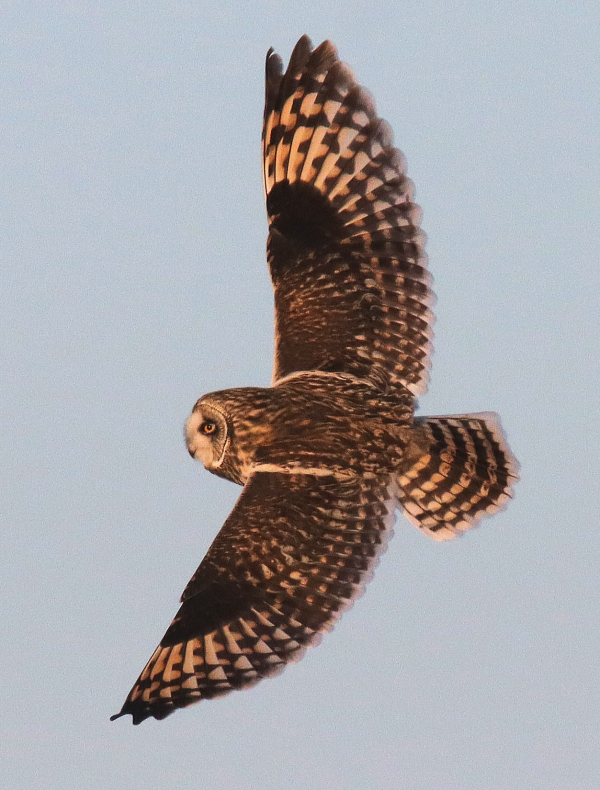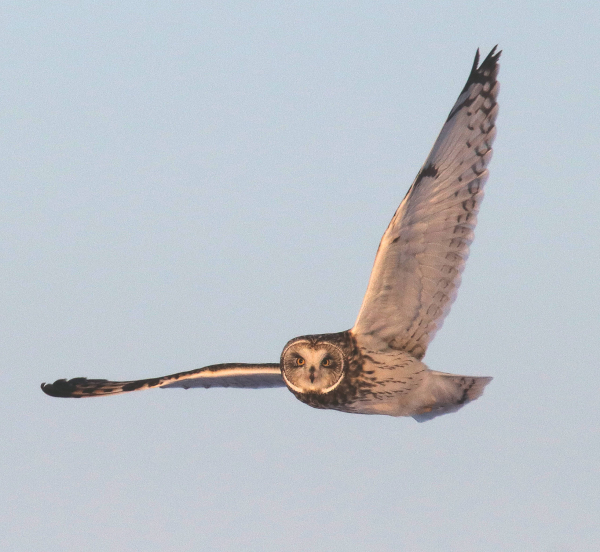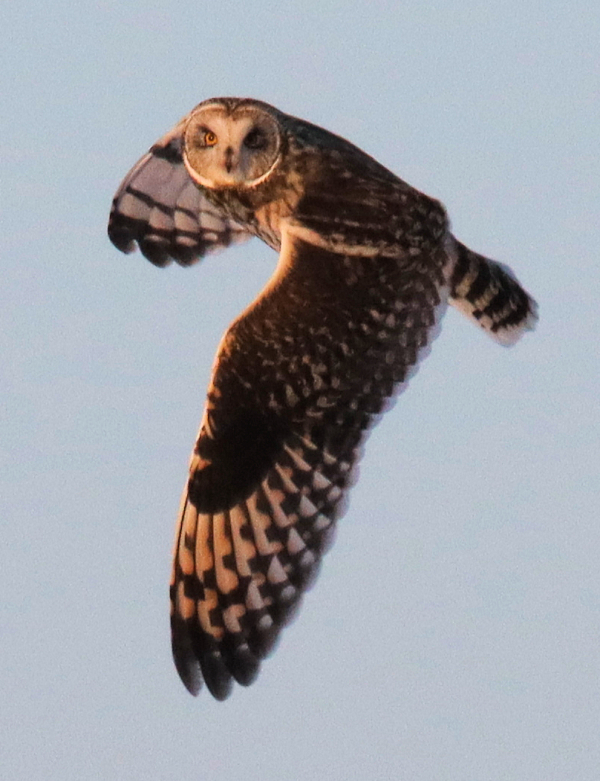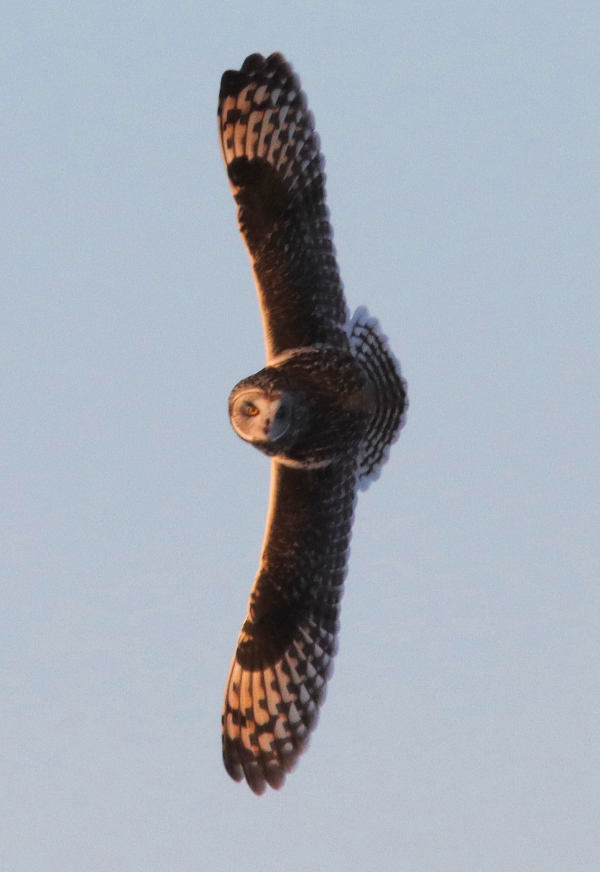
This is a favorite photograph among this series of flight photos of a Short-eared Owl, encountered just 1½ miles south of The Birding Wire office (600mm zoom lens, f-8 aperture, 1/2500 shutter speed, 800 ISO).
|
An afternoon getaway was short-stopped less than 2 miles south of my office when a flock of about 60 Snow Buntings caught my eyes as they were feeding and moving with a degree of symmetry. I observed the Arctic songbirds for some time, hoping they would move across the road where the sun would provide primo light for some photos. Waiting, watching, waiting; but after about a half-hour I noticed a distant silhouette of what appeared to be a bird of prey – most likely a Rough-legged Hawk or a Short-eared Owl, but I couldn’t tell from a silhouette a mile away. That was exciting in itself considering it had been a couple weeks since my last sighting of an owl, and longer for a hawk.
|
|
Breaking away from the Snow Buntings, I drove 2 miles to the next crossroad to see if I could get a better look at the big bird I spied in the distance. I spent some time parked at a vantage point with my car heater running frantically during the day’s high temperature period, hovering at a frigid –13 degrees, but didn’t relocate the bird that was obviously hunting when I saw it. Oh well, I retraced my route back toward the buntings, and just before I reached their foraging area I was surprised by a Short-eared Owl flying across my windshield view – close!
The owl’s buoyant flight took it into full view in the afternoon sunshine, so perhaps it would even yield a photo or 2. Excited, I tried to catch up to the Short-ear to get into an appropriate position, but it passed back across the road to hunt the edges where the cattails of a marsh met the short stubble of a grain field dusted with new snow. There I could only muster a couple fairly distant silhouette photos of the owl as it searched for a small rodent. While watching its hunt, twice the owl made strikes that took it to the ground, but neither showed evidence of a rodent catch. I watched and tailed the hunter from a distance, hoping it might cross the road to give me photo chances where the sun would light up its owlness.

When least expected the Short-eared Owl flew into the late afternoon sunlight, and although it was a distance away, I followed its flight through my camera’s zoom lens, taking some initial photos, but waiting for the hunting flight to turn in my direction. That happened a couple times as it swerved one way, then the other, but twice the long-winged owl made dramatic turns toward me, and that’s what I was waiting for. I took full advantage of those 2 turns into the sun, taking photos at key points in the process. Even through the zoom lens I could see that the owl seemed to interrupt its downward view for rodents to look directly at me as it waved its long wings in the freezing light wind.


During its second rise and turn, the owl looked toward the photographer with its long wings low, showing a different flight position. By anticipating the action, another interesting flight photo was created that compliments the others (600mm zoom lens, f-8 aperture, 1/2500 shutter speed, 800 ISO).
|
Too soon the owl winged farther north and crossed the road again, leaving me to hope for more, but instead the owl disappeared. But how? It must have landed behind the frozen marsh’s rim of cattails. While I waited to see if the Short-ear would reappear, I checked to see what the photos I just took looked like on the small LCD screen on the back of my camera. I was momentarily thrilled to see that I managed to get a couple photos that showed key moments during the owl’s dramatic turns. Would they translate into sharp photos on the big screen of my computer when I reviewed them within the hour?
Indeed, I was doubly thrilled to see some of the dramatic photos I managed to take, but as I cropped the photos, it was apparent the Short-eared Owl was positioned just a little too far away when I took the photos. The images of the owl were sharp enough to crop, but in the process, the enlarged images showed a fair amount of fine grain in the sky. The grain wasn’t so noticeable on the owl itself, but I wished I could remove the graininess, especially in the open sky background – hmm.

An especially dramatic photo of the Short-eared Owl in the midst of a full 180-degree tilt while facing me head on. This was the first photo I took, when the owl was quite a distance away, so when the photo was enlarged this much, the tiny grainy spots became all too evident (600mm zoom lens, f-8 aperture, 1/2500 shutter speed, 800 ISO).
|
Well, we all strive for a level of perfection in our photos, and perhaps a simple solution would be to enlarge the photo less in the cropping process and include more of the background. After all, my first crop was for a best case scenario; now that I could see the results, the owl images looked great but the graininess was kinda detracting. Step 2 might be to replace the uniformly colored sky background, but not this week, if at all.
Realistically, there isn’t much I could do that didn’t compromise the quality of the photo in other ways. It’s probably easiest to try, try again when another Short-eared Owl appears to make dramatic turns in a frigid sky – but a little closer next time. That shouldn’t take more than a few years, or decades – ha! Or we can appreciate the photos for what they are, enjoy them, share them, and most people who view them won’t notice, ‘cuz they don’t look for every little flaw in a given photograph. They see the owl in dramatic flight positions.
I hope you enjoy these Short-eared images, and if you squint a little you can barely see the tiny grain in the photographs. Enjoy your week, and I hope you have at least one surprising bird to photograph along your meanderings. Saturday is the first of March, so there should be many more birds to photograph as the season progresses.
Article and Photographs by Paul Konrad
Share your bird photos and birding experiences at editorstbw2@gmail.com